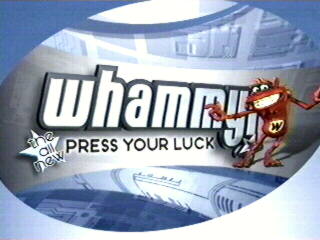| GAME RULES |
 |
| The board from the pilot. Note the ugly stencil logo and screwy board layout. I mean, since WHEN was $200 + a spin THERE? |
| After the miserable failure of Carruthers Company's "Second Chance", they took advantage of the saying "If at first you don't succeed, try, try again", and created Press Your Luck in 1980, hosted by Pat Sajak, known at the time only as a weatherman. This also failed, but later returned in 1983, hosted by Peter Tomarken, former host of Hit Man, and the all-too-familiar Rod Roddy. To Carruther's big surprise, the show this time was a hit, and would soon become TVDaily's #1 Game Show of All Time. So how did such a good show work, anyways? The game consisted of 2 main rounds, each with the "potty-break time" Question Round, and the "Better Hurry!" Big Board Round. The Question Round consisted of four (5 in the pilot) ridiculously easy questions. A player could buzz in with an answer after the question was asked. Then Peter would read the player's answer as well as two others. A correct buzz-in answer netted you 3 spins, and a correct multiple choice answer, 1 spin. |
 |
| BEEP BEEP BEEP! This is the sound of a player buzzing in for a chance at three spins. |
| The spins were taken over to the big board round, which had tons of cash and prizes. 18 screens with 3 projectors aimed at each one showed all sorts of prizes. A square of light surrounding each screen bounced around the board at what seemed to be random (Michael Larsen proved them all wrong). The player "stopped" the board by slamming on the button they used to buzz in in the question round. Whatever prize the light square was surrounding at the time the board was stopped is what the player won. But the square might also contain the dreaded Whammy, which snatched everything the player had won, mocked them in an animation (and usually got embarrased in the process), and made a yellow Whammy card pop up in front of the unfortunate contestant. This kept track of how many Whammies the player had hit, which was a good thing, as 4 Whammies in one game automatically eliminated that contestant from further play. |
 |
| Stop at a Whammy! This unfortunate man stares in disbelief as the Whammy mows away his winnings. |
| However, if a player had 3 Whammies and feared a fourth, or had too much to lose, they could pass all their remaining spins to another player. Players had to pass their spins to the player in first place, except, of course, the first place player, who passed their spins to the second place player. If there was a tie for second (almost always two $0 players), the first place player could chose who to pass their spins to. |
 |
| BING! This is the sound of a player being passed spins that could bring more cash... or a Whammy! |
| Click a link below for a board tutorial. |

